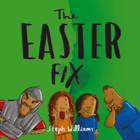
Jesus spoke and the girl came alive, the storm stopped, the blind man saw... I remember sitting in our church toddler group wondering what those around me would think of these miraculous stories. There were mothers, grandmothers and carers from very different walks of life: young mums from council estates alongside architects and paediatricians living in houses worth half a million; most were probably atheists or nominal Christians, and some were from other religions. How would they receive these stories?
Then one day, one of the mums shared that she had just lost her older child, a five-year-old who had had a long term illness. It was such a shock.
And it made my question about the relevance of our Bible stories sharper. We have a message of hope that speaks to questions of life and death, and into pain and darkness, yet this hurting woman could come week by week and possibly never hear this. We always explained the gospel in these Bible story times, but only in a brief sentence about sin and how Jesus paid our punishment. If only we could say more about all that means for life, death and our fallen world, I thought.
"We can break down false assumptions by explaining that God did not create a world of suffering and death, and has not given up on us."
The words we use in our gospel explanations can feel so far removed from everyday conversation. Concepts like sin and punishment are understood less and less, since our postmodern culture has lost the concept of God. These words can be associated with a kind of angry, personal vengeance and a negative self-image. In schools teachers have to use the word “consequence” for punishment and “choosing” for doing wrong. So when we share the gospel, it is difficult for people to see the truth of what we're saying.
I’m sure our stories and gospel explanations were not wasted—especially when we spent time praying. God can use them as seeds in those families' lives. But sometimes the words we use feel so distant from where our friends and family are at.
And yet, in reality, the gospel is not at all removed from what people around us are thinking about and deeply interested in! It is the story of how a world became broken, and one day will be fixed. Illness and death are the things that destroy our lives and that we feel most keenly—even more so in this past year. The gospel is all about these things! It gives the answer most people are desperately looking for.
There are many things about the gospel that our culture does actually get: the importance of freedom of choice (which God has given the human race, as we choose or reject him); the injustice of wrong done in relationships (we have damaged our relationship with God); and our need for a Saviour from suffering and death. These are connection points we can use! We often shy away from questions about suffering, for example, but these are opportunities. We can break down false assumptions by explaining that God did not create a world of suffering and death, and has not given up on us. He has acted to help us, and he is where we can find hope.

An engaging retelling of the Easter story that will help young children understand why Jesus died and came alive again.
We also need to explain concepts our culture doesn't get. We can show why it would be unloving for God not to be angry about sin. For many who think sin means unnecessary guilt, we need to connect it with wrongs they can relate to—things we all feel keenly in our own lives, such as the impact of our words to hurt others, or the pride with which we often look down on those around us. Using different words can help—not to avoid difficult concepts but to get across the accurate biblical meaning.
And it will take more than one conversation to make these connections and break down these barriers of misunderstanding. But I believe we can do this, both for adults and for children.
A couple of months after our friend shared her sad news, it was my turn to tell the Bible story. In the schedule was the story of Adam and Eve. I wrote a version of the story which would later develop into my new children’s book, The Easter Fix. Aware that the woman I mentioned was listening, I wanted to communicate something of what the Bible says to us in the brokenness of life that we and our children experience. I wanted to show something of the bigger picture that lies behind these individual Bible stories.
The Easter Fix tells the story of how Jesus came into our broken world. He showed us what God is like when he loved and healed people. He died for us to fix the thing that makes everything broken—our broken relationship with God. His resurrection shows us how one day everything will be fixed for ever, for those who trust in him.
Amazingly, I drew the story a few weeks before I was due to tell it, not knowing that the day before, our three-year-old son would almost completely sever the end of his finger in a door. After some hospital administrational delays, he was having it sewn back together at exactly the same time on Monday morning that I was in the toddler group pointing to the picture I had drawn weeks earlier to represent the fallen world. It was a picture of a boy holding up a bandaged second finger—the same finger as our son’s! It just seemed a small sign of how real and relevant God is, or possibly an encouragement that he meant that story to be written.
In the midst of a pandemic, we are faced more than ever with the brokenness of this world. Many are going through bereavement. I pray that The Easter Fix will give you something to share with children and families that talks about how God sent someone to fix things, and how one day everything will be fixed for ever for those who trust in him. Most of all, I hope it inspires you to think about ways you could share the gospel creatively with those who so desperately need to hear it.